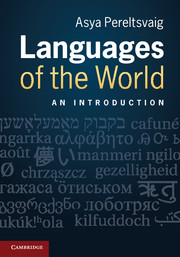Book contents
- Frontmatter
- Contents
- Figures
- Maps
- Tables
- Words, words, words…
- Acknowledgements
- Abbreviations used in the glosses
- 1 Introduction
- 2 Indo-European languages
- 3 Non-Indo-European languages of Europe and India
- 4 Languages of the Caucasus
- 5 Languages of Northern Africa, Middle East and Central Asia
- 6 Languages of sub-Saharan Africa
- 7 Languages of eastern Asia
- 8 Languages of the South Sea Islands
- 9 Aboriginal languages of Australia and Papua New Guinea
- 10 Native languages of the Americas
- 11 Macro families
- 12 Pidgins, creoles and other mixed languages
- Glossary
- References
- Index of languages
- Index of terms
2 - Indo-European languages
- Frontmatter
- Contents
- Figures
- Maps
- Tables
- Words, words, words…
- Acknowledgements
- Abbreviations used in the glosses
- 1 Introduction
- 2 Indo-European languages
- 3 Non-Indo-European languages of Europe and India
- 4 Languages of the Caucasus
- 5 Languages of Northern Africa, Middle East and Central Asia
- 6 Languages of sub-Saharan Africa
- 7 Languages of eastern Asia
- 8 Languages of the South Sea Islands
- 9 Aboriginal languages of Australia and Papua New Guinea
- 10 Native languages of the Americas
- 11 Macro families
- 12 Pidgins, creoles and other mixed languages
- Glossary
- References
- Index of languages
- Index of terms
Summary
In Chapter 1, we saw that the world's languages can be classified into language families, with the implication that all languages in a given family descend from a common ancestral language, or proto-language. In this chapter we turn to the most populous and one of the best-studied language families, namely the Indo-European language family.
Luckily for the study of Indo-European comparative linguistics, many of these languages have extremely old surviving written records: for example, the earliest records of Hittite go back to around 1,800 BCE; the earliest inscriptions in Mycenaean Greek date from 1,300 BCE; the oldest part of the Rigveda (written in an archaic dialect of Old Indic) probably goes back as far as 1,200 BCE; most ancient scriptures in Avestan, the liturgical language of Zoroastrianism, date from about 600 BCE; the Achaemenid Records in Old Persian are from about 500 to 400 BCE; and the oldest Latin inscriptions date from the sixth century BCE.
- Type
- Chapter
- Information
- Languages of the WorldAn Introduction, pp. 13 - 38Publisher: Cambridge University PressPrint publication year: 2012



